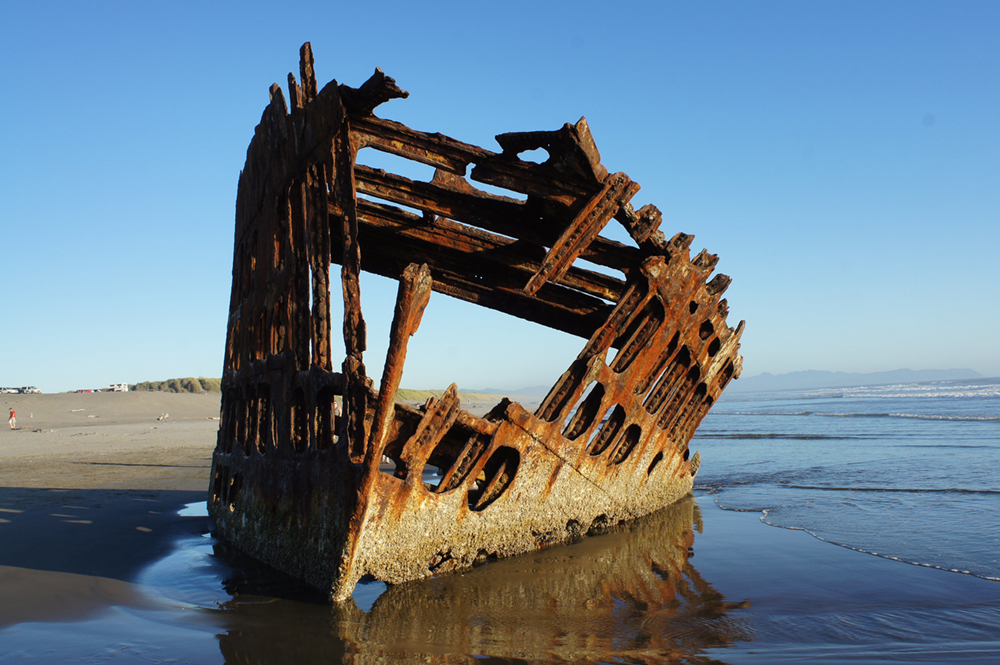
At Fort Stevens, a short walk on the beach and you will find the hull of the Peter Iredale
When you visit Astoria, after a lunch at Fort George Brewery, be sure to visit another fort, Fort Stevens State Park. The park’s visitor center and museum interpret the site’s long history. Tours through the old earthen fort and artillery gun batteries are also available. Those with a passion for the outdoors will enjoy the disc golf course, fishing, 15 miles of multi-use trails, and access to Coffenbury Lake for swimming and boating.
There are several camping options available in one of the country’s largest public campgrounds. All campsites are ADA accessible and come equipped with a picnic table and grill. Yurts and cabins are also available for rent. A day-use pass is required for entrance.
Along the rugged northernmost coast of Oregon lies Fort Stevens State Park, a place where history intertwines with natural beauty, offering visitors a glimpse into the past and endless opportunities for outdoor adventure. From its military heritage to its diverse recreational activities, Fort Stevens State Park beckons travelers to explore its captivating landscapes and rich history.
Fort Stevens holds a significant place in Oregon’s history, dating back to the Civil War era when it was constructed to protect the Columbia River and the city of Astoria from potential naval attacks. The original fort was complete in 1865 and was built to protect the mouth of the Columbia River from the British Navy and Confederate gunboats during the Civil War. Named after Isaac Stevens, the first governor of the Washington Territory, the fort played a crucial role in defending the region during times of conflict, including the Spanish-American War and World War II.
During World War II, Fort Stevens was attacked by a Japanese submarine, becoming the only military installation in the continental United States to come under enemy fire since the War of 1812. Today the public can explore the remnants of this wartime past including gun batteries, bunkers, and other fortifications.
Embark on a journey through time as you explore the fort’s military relics and structures. Wander through the Battery Russell, the site of the Japanese submarine attack, and imagine the tense moments of battle that once unfolded here. Visit the military museum to learn more about the fort’s role in defending the Pacific Northwest.
Beachcombing and Wildlife Viewing
Fort Stevens boasts miles of pristine coastline, making it a haven for beachcombers and wildlife enthusiasts alike. Stroll along the sandy shores, search for seashells and driftwood, and keep an eye out for shorebirds, seals, and even whales migrating along the coast.
A short trail from the parking lot leads to the Peter Iredale shipwreck at Fort Stevens State Park.
Peter Iredale was a four-masted steel barque that ran ashore October 25, 1906, on the Oregon coast enroute to the Columbia River. Sailing from Mexico, Peter Iredale was bound for Portland, Oregon with 1,000 tons of ballast and a crew of 27, including two stowaways. Under strong winds out of the west, an attempt was made to hold the ship away from shore, but a heavy northwest squall grounded the Peter Iredale on Clatsop Spit. High seas and wind drove the ship ashore. A lifeboat was dispatched from Hammond, Oregon and assisted in evacuating the sailors. No casualties occurred in the accident.
Hit the trails and explore the park’s diverse landscapes on foot or by bike. With over 6 miles of paved paths and numerous unpaved trails, there’s no shortage of routes to discover. 15 miles of multiuse trails will lead you through coastal forests, dunes, and wetlands, and soak in the breathtaking vistas of the surrounding terrain.
At Coffenbury Lake there are two picnic areas with swimming, restrooms, and boat ramp. A 2-mile trail circles the lake.
Columbia Shore Disc Golf Course is set at Fort Stevens historic area, next to the Columbia River. Its recommended to play in the morning to avoid the wind.
Take in the views of the Columbia River Bar from the South Jetty Observation Tower. The Columbia River jetty system, constructed between 1885 and 1939, allows for safer passage for vessels moving between the ocean and the river.
Cast a line into the Columbia River or try your hand at crabbing along the shore. Fort Stevens offers excellent fishing opportunities, with salmon, steelhead, and sturgeon among the prized catches. Bring your own gear or rent equipment from nearby vendors and enjoy a day of angling in the great outdoors.
Camping
Spend a night under the stars and experience the magic of camping at Fort Stevens State Park. Choose from a variety of camping options, including tent sites, RV hookups, and cozy yurts nestled amidst the trees.
Whether you’re a history buff, outdoor enthusiast, or simply seeking a peaceful retreat by the sea, Fort Stevens State Park offers something for everyone. From its storied past to its boundless recreational opportunities, this coastal gem invites visitors to embark on a journey of exploration and discovery, leaving behind memories that will last a lifetime.
Vehicle access points are located at Fort Stevens near Peter Iredale Beach, Sunset Beach, Del Rey Beach, and in Gearhart at 10th Street.
